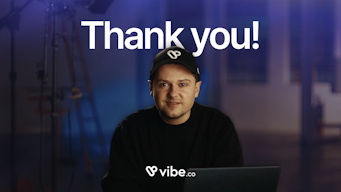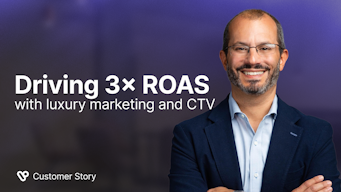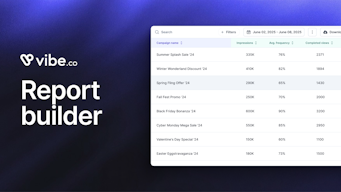How To Create Video Ads
Why is video marketing so effective
Video marketing is uniquely effective in creating an emotional connection with your audience, mainly thanks to its unique ability to captivate and engage audiences in a way that other forms of content cannot. When the rise of smartphone technology made watching videos easier and more convenient, it only accelerated the growth of video marketing, further boosted by the pandemic. Today, online media consumption in the US is up 215% since 2018. Video ads have become a non-negotiable medium for any organization relying on marketing as a major tool to attract prospects.
Creating compelling video ads is especially useful to increase customer engagement, leverage versatile assets across channels (social, website, CTV ads, etc.), boost SEO, develop a trusting relationship with your audience, showcase your products or services in a simple way, and more. Let’s take a closer look at some of the ways video ads can benefit your business.
- Increased Engagement: Videos capture viewer attention 10x more effectively than text or static images. They offer dynamic content that keeps viewers engaged for longer periods, with higher recall, so audiences are more likely to take action and/or share your video with others. Videos with sound are especially engaging, with streamed TV ads boasting 97% average VTR (view through rate).
- Versatile and Shareable: Videos are easy to share across platforms, increasing their potential reach past your immediate audience. Thanks in large part to the rise of social media and ubiquitous mobile devices, videos have become a preferred format for users to consume and share content, leading to organic growth and expanded brand exposure.
- Demonstrating Products or Services: Videos allow businesses to showcase their products or services in action, providing a more tangible and immersive experience for potential customers. Demonstrating features, benefits, and real-life use cases through videos helps build trust and confidence in the brand.
- SEO Benefits: Search engines prioritize video content, and incorporating videos on websites and social media platforms can improve search rankings. Video descriptions, titles, and tags provide additional opportunities for optimization and increase the likelihood of appearing in search results.
- Brand Trust: A simple storytelling arc and compelling testimonials can go a long way to building both brand awareness and trust. Consumers today are hungrier than ever for authentic brand voices and values, and there is no more compelling way to tell your story than through the camera. Identify your key selling points and identify which company values will resonate most with which type of audience for a simple, impactful video.
Leverage the visual and emotional impact of videos to effectively convey your message, engage your audience, and drive stakeholder action. The combination of storytelling, engagement, and versatility makes video marketing a powerful tool for businesses to connect with their audience and reach their marketing objectives.
Pick your Video Ad Distribution Channels
When it comes to deciding which marketing channel to use for your videos, it's important to align your media mix with your marketing goals. Consider where your audience typically spends most of its time, and which unique advantages each channel type offers before creating your video ad, since different formats will meet different needs. Let's take a look at the ways in which different video channels can enhance different types of campaigns.
- Social Media: Social media platforms like Facebook, Instagram, TikTok, or LinkedIn are especially useful for engaging with your audience and driving traffic to your website. If your goal is to foster customer interaction and leverage user-generated content, social media channels can be especially useful. But remember, unless you are working with influencers or creating long-form branded content, your social media video ads will be muted and easy to scroll past, so make sure they are graphically compelling with a compelling CTA on-screen for the length of the video.
- CTV Advertising: Connected TV (CTV) advertising allows advertisers to reach viewers on streaming platforms like Hulu, Roku, and Peacock. This channel brings together the premium brand associations of television with the power of digital marketing. It allows brands to compellingly tell their stories and target specific demographics. If your goal is to reach audiences with engaging creative on a premium platform, CTV advertising is a great way to go.
- YouTube Ads: YouTube is the second-largest search engine and a powerhouse for video content. It's great for increasing brand exposure, reaching a wide audience, and driving conversions. If your marketing goals involve leveraging video SEO, and driving website traffic, YouTube ads are an excellent choice.
- Digital Out Of Home: Digital Out Of Home (DOOH) advertising refers to video ads displayed on digital screens in public spaces like billboards, transit stations, and shopping malls. New self-serve providers like Blip now allow advertisers to optimize, target, and track campaign KPIs more efficiently and economically even on billboards. Control your cost and scale your campaign fast with programmatic digital billboard campaigns that can deliver relevant ads to targeted audiences at the perfect moment when they walk or travel past the digital signage, and respond coherently to your ads running on other, complementary channels.
- Website: Your own website acts as a hub for your brand's online presence. It's ideal for driving conversions, building customer loyalty, and providing in-depth information about your products or services. If your goal involves guiding users through the customer journey, promoting specific offerings, and capturing leads, leveraging video content on your website is crucial.
- Google Display: Google Display Network (GDN) offers a vast reach across websites, mobile apps, and YouTube channels. It's suitable for increasing brand awareness, driving website traffic, and retargeting potential customers. If your goal involves reaching a broad audience, increasing brand recognition, and leveraging contextual targeting, Google Display ads can be a valuable choice.
Ultimately, the right marketing channel for your videos depends on you, so consider your target audience, budget, and desired outcomes at the beginning of your video ad creation process. It's often beneficial to employ a mix of channels to maximize your video marketing efforts and achieve a well-rounded campaign.
How to Create Video Ads
Best video tools
Depending on the type of ad you’re trying to create, you will need more or less complicated editing tools. Luckily, there already exists a vast range of affordable online tools to get you started. Here are some of our favorites.
Canva
Canva is a great free video ad creation tool for beginners, especially since most are probably already familiar with its functionality for static graphic design. With its user-friendly interface and extensive library of templates, Canva empowers users to effortlessly design professional-looking video ads. Its comprehensive selection of customizable elements, including text, graphics, and animations, allows for impactful branding and customization. Canva's intuitive drag-and-drop functionality enables users to quickly arrange and edit their content and collaborate with their team in real-time, at no or low cost.
Vimeo
With its intuitive interface and robust features, Vimeo empowers creators to create visually stunning, professional-grade video ads. Its comprehensive suite of editing tools allows for seamless trimming, cropping, and adding effects to enhance the overall visual appeal. Vimeo's diverse selection of customizable templates and themes caters to a range of ad styles, making it easy to create captivating content, while its powerful analytics provide valuable insights into viewer engagement. Vimeo is a reliable and versatile platform for creating and showcasing remarkable video ads with one of the best hosting and reach in the industry.
InVideo
InVideo is especially helpful for social media and testimonial ads filmed on a smartphone. Its intuitive drag-and-drop functionality and customizable elements, such as text, graphics, and transitions, help creators create, edit, and publish their video ads in just a few hours. InVideo also offers advanced editing options, including audio enhancements and video effects, allowing users to create polished and professional ads. With its InVideo streamlines the creative process. Overall, InVideo's versatility, seamless integration of stock footage and music, and ease of use, make it a standout video tool.
Animoto
Animoto offers an extensive library of customizable templates with drag and drop functionality, making it easy to create visually appealing video ads with stock media assets. Users will, however, need to purchase a subscription if they want to create longer, higher quality videos, especially if they want to use stock media without a watermark.
Adobe
A household name for decades, Adobe offers a range of powerful and professional-grade editing tools, allowing for extensive customization and creative control. Its vast library of effects, transitions, filters, motion tracking, and 3D editing enables users to create visually stunning video ads. The learning curve for using Adobe's software can, however, be steep for beginners; but Adobe remains a top choice for users seeking robust and feature-rich video ad creation capabilities.
Freelance video editors
Freelance marketplaces like Fiverr or Upwork can be a great resource for businesses looking to wet their feet in video ad creation without committing to costly software subscriptions. As long as you film your ad with high enough quality lighting and a Smartphone camera or better, a good video editor should be able to create something great! Most freelance video editing costs somewhere between $50 and $150 an hour.
Best Practices
Videos combine visual and auditory elements, creating a multi-sensory experience that resonates with viewers on a deeper level, so don’t sell yourself short. While Google Ads and muted social media videos may have taught you hope to hyper-condense your messaging, unskippable video ads streaming or native video content on social is where your brand story and values can really shine, so focus on one or two per ad and add as much visual and auditory interest as you can.
That being said, the appeal of targeted video ads - for both advertisers and viewers - is their relevance, which means you can make a harder sell than you would in brand awareness video. That can mean keeping your url on-screen at all times, repeating a strong CTA (Call To Action) several times throughout the video, or including a QR code and/or discount code. Either way, get to the point and repeat it! Viewers can’t act on your message if it’s not clear. They will be all the more likely to engage if you customize your messaging by segment. Streaming and social video advertising allows marketers to target by zipcode, gender, income, interest, and more, so get specific! With just a few more takes featuring demographic-specific elements, your videos can now speak directly to your various customer segments.
And finally, test early and test often. Real time reporting and optimization mean you can edit your ads as soon as you detect an issue or opportunity. No more wasted impressions!



